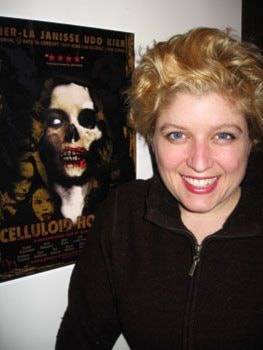Veterans might have much more trouble reconciling memories of war with contemporary dance.
But Crystal Pite insists the two are similar.
There’s a commonality between “the loss of veterans and their stories and the loss of our dancing,” said the Vancouver-based dancer and choreographer.
Dance is ephemeral. It’s fleeting.
“I think a lot about our work as dance artists,” said Pite, taking a break from rehearsal at the Yukon Arts Centre on Wednesday.
“It’s intangible,” she said.
“Everything we do keeps disappearing — we have no artifacts — there’s nothing to take home.
“It’s a good metaphor for life and death.”
Although Pite is only 38, her dancing days are numbered.
It’s a discipline that’s hard on the body.
Slender, almost sinewy, Pite is fit.
She still dances, but now works within her own creations, rather than under other choreographers.
“I’m happy dancing in my own work,” said Pite, who’s performed for more than 30 choreographers all over the world.
“As a choreographer, I know the dancer in me so well — I know what I can do and what I can’t.”
Switching hats isn’t hard for Pite.
“Both dance and choreography feed off each other so much,” she said.
“And my choreography is affected by my experience as a dancer.”
Pite, the youngest artist to receive the esteemed Clifford E. Lee Choreographic Award, formed her own company, Kidd Pivot, six years ago.
The troupe is in Whitehorse performing Lost Action, a 70-minute piece that won the Alcan Performing Arts Award for dance in 2006.
The piece formed out of a chance encounter Pite had in Montreal.
It was November, and the dancer had a poppy on her backpack. An American approached Pite and asked about all the poppies.
“I began thinking about war,” she said.
“It’s hard to understand from our place of privilege and relative peace.
“So I wanted to get a better understanding of it through dance.”
The piece contains a reoccurring loop — the image of a man on the floor with dancers bending over him.
“Repetition is important because of the cycles of war, peace and violence,” said Pite.
And in life repetition is inevitable, she added.
Interested in what it looks like to fix dance in time and space, Pite has dancers grabbing onto each other, and holding images.
“Dance gets to you in ways that are beyond words,” she said.
“It’s very visceral.”
On the stage Pite’s troupe ran through a sequence over and over again, their bodies lifting and joining until it was hard to separate limbs and torsos.
“I have been performing since I was a child,” said Pite, who started dancing at the age of four.
Although she was classically trained in ballet, Pite’s company meshes all styles of dance, resulting in a contemporary montage.
“It’s a hybrid of many forms,” she said.
“The ballet aesthetic is pretty buried.”
Lost Action also draws on an original composition by Owen Belton, a composer Pite has been working with for the past 15 years.
The music is also a montage, beginning with scratchy old folk tunes and adding dialogue spoken over the recordings by the dancers.
Lost Action, taken from the phrase, “lost in action,” doesn’t tell a story, said Pite.
It’s more narrative fragments — like snippets of memory, she said.
Pite wants to affect people with her works. “It’s not complete until it’s shared,” she said.
“But I don’t want to manipulate people or force them to see it in a particular way,” she added.
It’s not a matter of intellectually understanding the piece, or interpreting it.
“I just want people to have an experience here they may not be able to articulate in words,” said Pite.
“I want to touch them in ways that are beyond words.”
Lost Action is at the Yukon Arts Centre tonight.
The show starts at 8 p.m. and tickets are $25, students and seniors pay $15.
